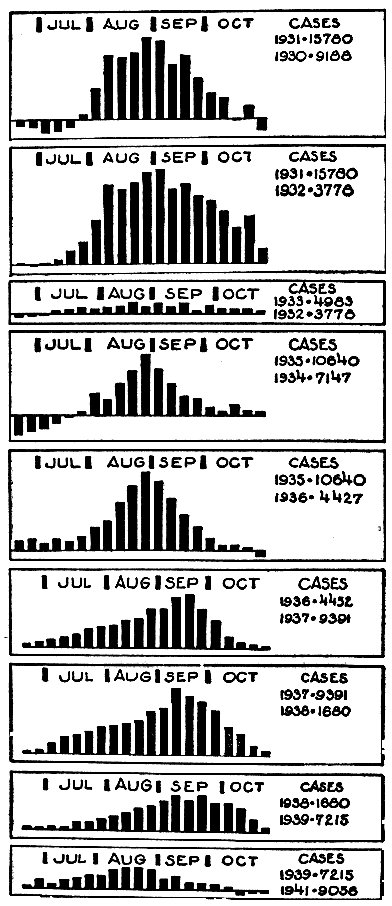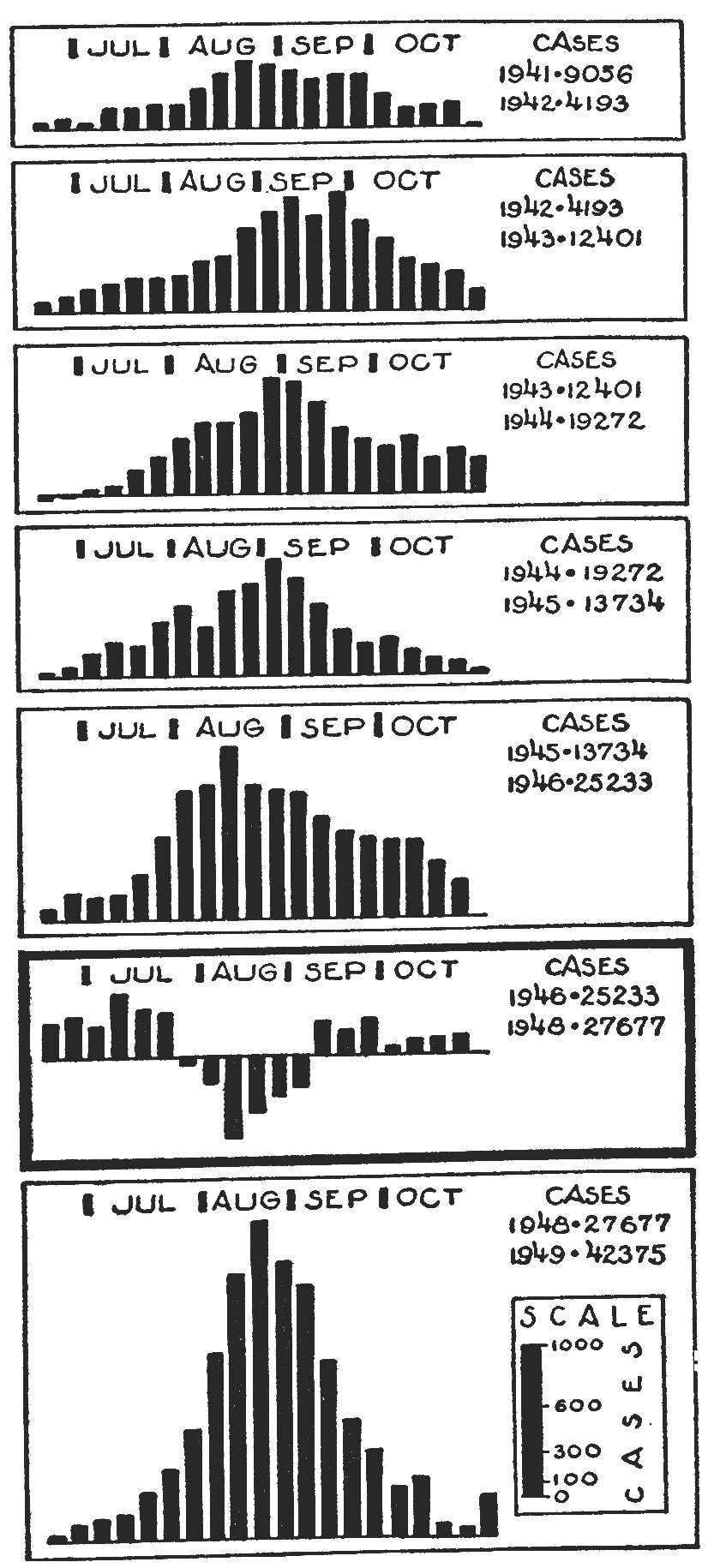 FIG 11
FIG 11[back]
POLIO IN 1949
The country as a whole had more cases of polio in 1949 than in any previous year. There were 38,153 cases in 1949 against 23,418 in 1948. There was no diet campaign during 1949. However, a study of the 1949 statistics yields some interesting data. I wish to call attention to a great decrease in polio cases in Asheville and in the state of North Carolina during 1949, in spite of the fact that 1949 for the country as a whole was far worse than 1948. In 1949, 39 states showed an increased number of cases over 1948. Ten states and the District of Columbia show a fall in the number of cases, and of these, North Carolina shows the most striking reduction. The following figures released by the National Office of Vital Statistics of the U. S. Public Health Service are submitted:
Examples of states showing increases in 1949:
Oct. 29, Jan. 1 to
1949 Oct. 30, 1948
Massachusetts 1,705 181
New York 5,072 1,321
New Jersey 1,350 715
Michigan 2,568 662
Texas 2,123 1,611
Illinois 2,705 1,013
Oklahoma 1,216 339
Examples of states showing decreases in 1949:
North Carolina 214 2,402
South Carolina 98 355
Georgia 201 215
Florida 228 245
California 2,156 4,150
Total Cases for the United States .38,153 23,418
The most striking figure is the great reduction in number of cases in North Carolina. In 1949, there was about one-twelfth the number of cases in 1948. The city of Asheville had only 5 cases in 1949 as against 76 in 1948. A study of these figures also indicates that a heavy epidemic (as in 1948) is not followed necessarily by a reduced epidemic (as in 1949). There is no evidence to support contention that a city or state develops an immunity during a severe epidemic year. If this were true, then 1949 should never have been so much more severe than 1948. Those who believe that the reduced number of cases in Carolina and Asheville in 1949 was due to immunity acquired in 1948, will find difficulty in explaining the rise in number of cases in states that had many cases in 1948.
The fact that four of the ten states showing a number of cases in 1949 were located in the southeast part of the country may be attributed to the widespread publicity given the diet suggestions in that area. Because of the severity of the North Carolina epidemic, adjoining southern states had wide newspaper and radio publicity made available by the AP and UP wire services and practically every newspaper carried the story. Countrywide newspaper and radio publicity was also obtained but to a lesser extent. For example, in New York City, only one newspaper, The New York Times, carried the story.
I am convinced that the unique and striking reduction in the number of cases in 1949 for Asheville and Carolina is not accidental. Practically all citizens in Ashville with whom I have discussed the matter are of the same opinion. I have ample and reliable evidence obtained by direct questioning that the parents of Asheville remembered the diet suggestions of 1948 and followed them in1949. They had cut the diet story from their newspapers to save for future reference.
The National Foundation for Infantile Paralysis has informed me that there was a sharp and significant drop in the sales of soft drinks and ice cream in North and adjoining states. The National Foundation had made their own investigation to ascertain to what extent the public had followed my suggestions. They have also stated that the consumption of soft drinks was less in 1949.
 FIG 11
FIG 11
Ten states and the District of Columbia had fewer polio cases in 1949 than in 1948, as against 38 states which showed marked increases in 1949 over 1948. Of the ten states showing declines in 1949, the greatest decline in the state of North Carolina, with South Carolina running second. In 1948 the state of North Carolina had a case rate of 66.3, the second highest rate in the country for that year. In 1949, the state of North Carolina had a case rate of only 6.3, the second lowest in the country for that year. In 1948 the state of South Carolina had a case rate of 19.2, and in 1949 had a case rate of 5.4, the lowest in the country that year.
Figs. 11 and 12 show a very significant event in the history of polio in this country since 1931. Each graph represents a comparison between two years, one of the years having had more cases than the year with which it is being compared. Each solid bar on a graph represents the number of cases by which the greater year exceeded the lesser year during a corresponding week. You will notice that once it is apparent that a particular year is running ahead of the year with which it is being compared, the bars on the graph lie above the baseline for duration of the epidemic.
This pattern is true for all the graphs except the graph which compares 1946 and 1948. You will notice that for the first time the bars on the graph become inverted during August and September due to the fact that 1948 fell behind 1946 in number of cases for six consecutive weeks during those months, although 1948 had been running well ahead of 1946 during June and July. This difference in for 1948-1946 is striking and unique. It is unique because it had never happened before, and it is striking because the change in pattern occurred exactly during the week when the diet story for preventing polio was released-throughout the country.

Certainly such a radical change in epidemic pattern cannot be regarded as accidental. The burden of proof falls on those who would regard it as accidental. The usual pattern is present in the graph comparing 1949 and 1948. Nineteen forty-nine greatly exceeded 1948 in the number of cases and the bars on the graph are all in the upright position because 1949 was always ahead of 1948. There was no diet campaign during 1949 and so the epidemic ran its usual course in most of the country.